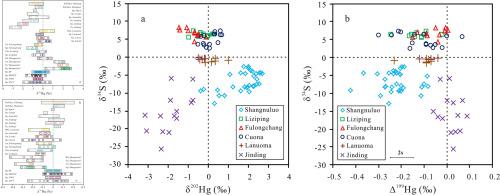当前位置:
X-MOL 学术
›
Chem. Geol.
›
论文详情
Our official English website, www.x-mol.net, welcomes your
feedback! (Note: you will need to create a separate account there.)
Mercury and sulfur isotopic composition of sulfides from sediment-hosted lead-zinc deposits in Lanping basin, Southwestern China
Chemical Geology ( IF 3.6 ) Pub Date : 2021-01-01 , DOI: 10.1016/j.chemgeo.2020.119910 Yue-Fu Liu , Hua-Wen Qi , Xian-Wu Bi , Rui-Zhong Hu , Lin-Kun Qi , Run-Sheng Yin , Yong-Yong Tang
Chemical Geology ( IF 3.6 ) Pub Date : 2021-01-01 , DOI: 10.1016/j.chemgeo.2020.119910 Yue-Fu Liu , Hua-Wen Qi , Xian-Wu Bi , Rui-Zhong Hu , Lin-Kun Qi , Run-Sheng Yin , Yong-Yong Tang

|
Abstract The Lanping basin is an important Pb-Zn-Cu-Ag polymetallic province in southwestern (SW) China. Mineralization types in the basin include mainly MVT Pb-Zn deposits, vein-type Cu deposits, and minor quartz vein-type Pb-Zn deposits. In this study, we analyzed the total Hg (THg) content and Hg-S isotopic compositions of sulfides from two types of Pb-Zn deposits in the basin, and investigate the Hg isotope fractionation mechanism and its major controlling factors in the Pb-Zn ore-forming process. At the Shangnuluo quartz vein-type Pb-Zn-Sb deposit, sulfides (especially sphalerite) show a wide δ202Hg range (−0.40 to 2.71‰), suggesting that Hg0 evaporation from hydrothermal fluids occurred during the ore formation. Negative THg vs. δ202Hg correlation in the sphalerites suggests a mixing of Hg from the vapor phase (low δ202Hg, high THg) and the residual aqueous phase (high δ202Hg, low THg). The negative ∆199Hg (−0.42 to −0.08‰) suggests that the Hg was sourced from the metamorphic basement, whereas the negative δ34S values (−13.0 to −2.7‰) suggests that the sulfur was mainly sourced from sedimentary sequences, possibly related to the organic matter decomposition and thermochemical sulfate reduction (TSR). For the Liziping and Fulongchang MVT Pb-Zn deposits, sulfides have relatively narrow δ202Hg range (−1.46 to 0.25‰), suggesting limited Hg0 evaporation during the mineralization. Lower δ202Hg values were observed in the early-stage sulfides from these two deposits, probably due to the preferential precipitation of lighter Hg isotopes in these early-stage sulfides. Sulfides from both deposits have negative ∆199Hg values (−0.24 to 0.01‰), suggesting that the Hg was also derived from the metamorphic basement. Sulfide δ34S values from the two deposits are positive, which also suggests that the sulfur was sourced from sedimentary sequences, but mainly related to TSR under relatively low-temperatures. Sulfides from different Pb-Zn deposit types in the Sanjiang Tethyans Metallogenic Belt fall into distinct fields in the δ34S vs. δ202Hg (or ∆199Hg) diagrams, indicating that the integration of S and Hg isotopes is useful to discriminate different types of Pb-Zn deposits.
中文翻译:

兰坪盆地沉积物铅锌矿床硫化物汞硫同位素组成
摘要 兰坪盆地是我国西南部重要的铅锌铜银多金属产区。盆地成矿类型主要有MVT型铅锌矿床、脉型铜矿床和少量石英脉型铅锌矿床。本研究分析了盆地内两类铅锌矿床硫化物的总Hg(THg)含量和Hg-S同位素组成,探讨了Pb-Zn矿床中Hg同位素分馏机理及其主要控制因素。成矿过程。上奴洛石英脉型Pb-Zn-Sb矿床硫化物(尤其是闪锌矿)的δ202Hg范围较广(-0.40~2.71‰),表明在成矿过程中发生了热液中Hg0蒸发。闪锌矿中的负 THg 与 δ202Hg 相关性表明来自气相的 Hg 混合(低 δ202Hg,高 THg)和残留水相(高 δ2O2Hg,低 THg)。负的 ∆199Hg(-0.42 至 -0.08‰)表明 Hg 来自变质基底,而负的 δ34S 值(-13.0 至 -2.7‰)表明硫主要来自沉积层序,可能与有机物分解和热化学硫酸盐还原 (TSR)。对于李子坪和福隆场 MVT Pb-Zn 矿床,硫化物的 δ202Hg 范围相对较窄(-1.46 至 0.25‰),表明成矿过程中 Hg0 蒸发有限。在这两个矿床的早期硫化物中观察到较低的 δ202Hg 值,可能是由于这些早期硫化物中较轻的 Hg 同位素优先沉淀。来自两个矿床的硫化物都有负的 ∆199Hg 值(-0.24 到 0.01‰),表明汞也来自变质基底。两个矿床的硫化物δ34S值均为正值,这也表明硫来源于沉积层序,但主要与较低温度下的TSR有关。三江特提斯成矿带不同铅锌矿床类型的硫化物在δ34S vs. δ202Hg(或Δ199Hg)图中属于不同的领域,表明S和Hg同位素的整合有助于区分不同类型的Pb-Zn存款。
更新日期:2021-01-01
中文翻译:

兰坪盆地沉积物铅锌矿床硫化物汞硫同位素组成
摘要 兰坪盆地是我国西南部重要的铅锌铜银多金属产区。盆地成矿类型主要有MVT型铅锌矿床、脉型铜矿床和少量石英脉型铅锌矿床。本研究分析了盆地内两类铅锌矿床硫化物的总Hg(THg)含量和Hg-S同位素组成,探讨了Pb-Zn矿床中Hg同位素分馏机理及其主要控制因素。成矿过程。上奴洛石英脉型Pb-Zn-Sb矿床硫化物(尤其是闪锌矿)的δ202Hg范围较广(-0.40~2.71‰),表明在成矿过程中发生了热液中Hg0蒸发。闪锌矿中的负 THg 与 δ202Hg 相关性表明来自气相的 Hg 混合(低 δ202Hg,高 THg)和残留水相(高 δ2O2Hg,低 THg)。负的 ∆199Hg(-0.42 至 -0.08‰)表明 Hg 来自变质基底,而负的 δ34S 值(-13.0 至 -2.7‰)表明硫主要来自沉积层序,可能与有机物分解和热化学硫酸盐还原 (TSR)。对于李子坪和福隆场 MVT Pb-Zn 矿床,硫化物的 δ202Hg 范围相对较窄(-1.46 至 0.25‰),表明成矿过程中 Hg0 蒸发有限。在这两个矿床的早期硫化物中观察到较低的 δ202Hg 值,可能是由于这些早期硫化物中较轻的 Hg 同位素优先沉淀。来自两个矿床的硫化物都有负的 ∆199Hg 值(-0.24 到 0.01‰),表明汞也来自变质基底。两个矿床的硫化物δ34S值均为正值,这也表明硫来源于沉积层序,但主要与较低温度下的TSR有关。三江特提斯成矿带不同铅锌矿床类型的硫化物在δ34S vs. δ202Hg(或Δ199Hg)图中属于不同的领域,表明S和Hg同位素的整合有助于区分不同类型的Pb-Zn存款。










































 京公网安备 11010802027423号
京公网安备 11010802027423号